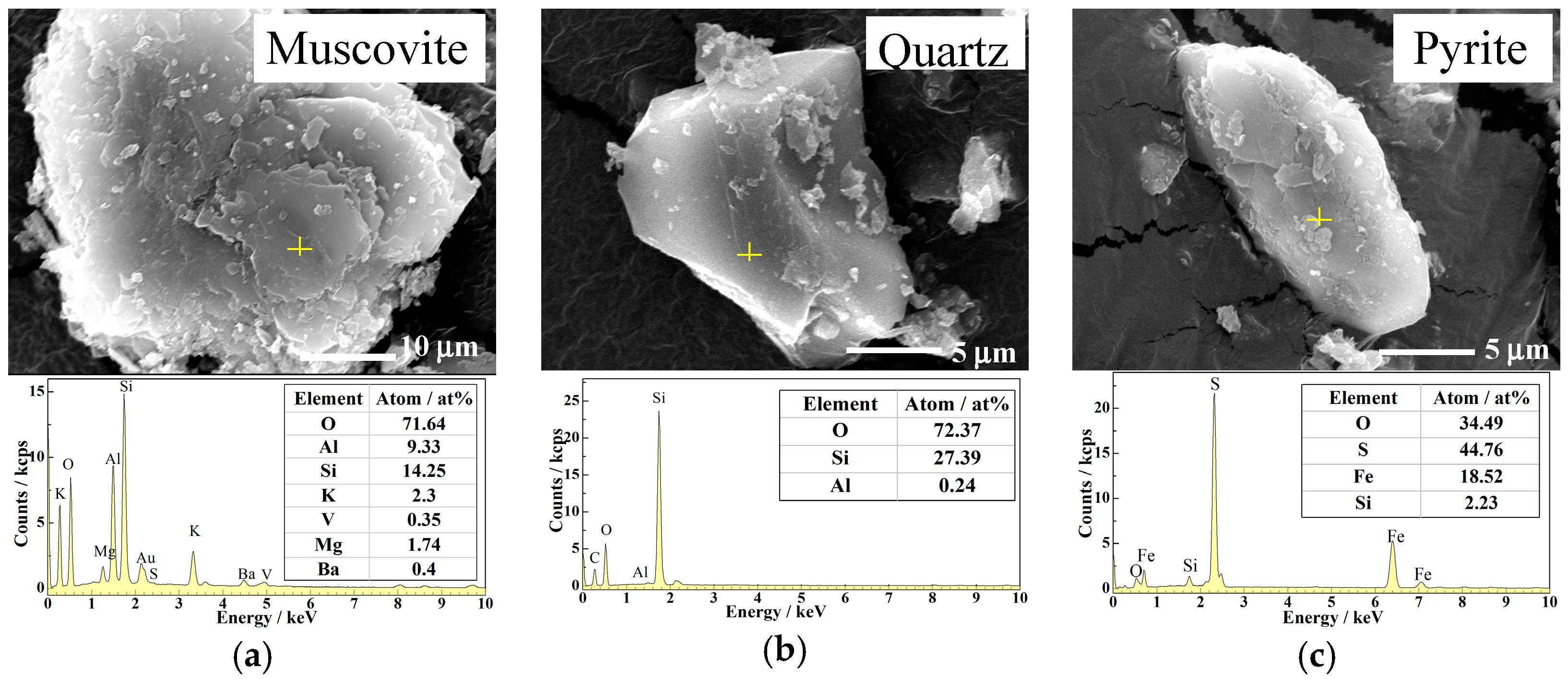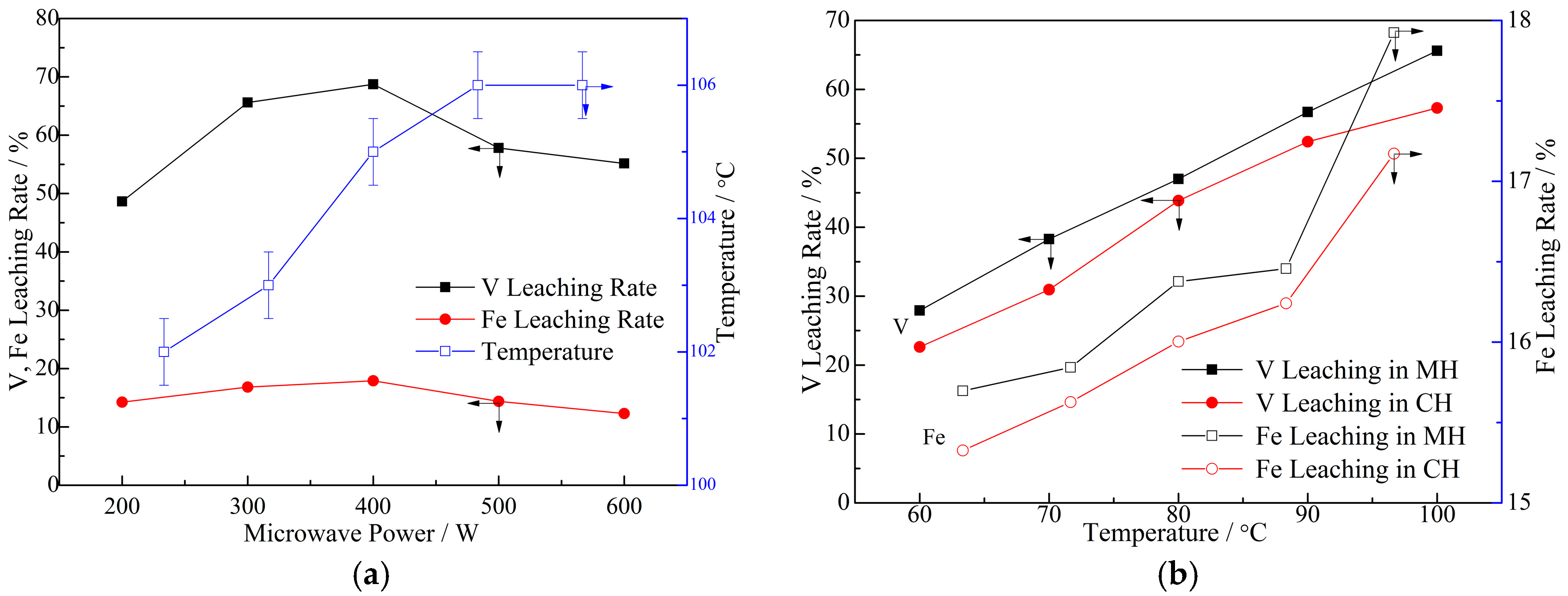3.1. Response Analysis and Interpretation
The experimental conditions in the design and the results are shown in
Table 4. The leaching efficiency of V in both microwave heating (MH) and conventional heating (CH) conditions designed by RSM were present. In Run 2 and Run 25, the V leaching rate difference of MH and CH was increased to 13% with the leaching time increased from 60.0 min to 150.0 min with no CaF
2 present. Compared with Run 17 and Run 19, with 10.0 wt % CaF
2 and 20.0 vol % H
2SO
4 used, the microwave improving effect was shown in the initial leaching stage, and then gradually disappeared. Meanwhile, in Run 13 and Run 14, the differences were generally less than 3%.
The ANOVA of quadratic model is presented in
Table 5, which proves the validity of the model. The Model
F-value implies the models are significant, and the value lack of fit implies that it is not significant relative to the pure error. In the fit summary, both of the two response factors were fitted for quadratic model. The proposed quadratic model agrees well with the experimental data, with correlation coefficients (R
2) of the factors of
Y1,
Y2 were 0.9931 and 0.9970, respectively. The predicted leaching of V in MH and CH, which do not show any significant nonlinear pattern indicating non-normality in the error term.
The value of Prob >
F less than 0.05 indicates that the model terms are significant. Values greater than 0.1000 indicate that the model terms are not significant. For the leaching of V, the influence order in MH (
Y1) was
X1 >
X2 >
X3 >
X1X2 >
X12. While in the CH (
Y2) condition, it was
X1 >
X2 >
X3 >
X1X2 >
X1X3 >
X12. CaF
2 usage has the greatest effect on V leaching with the highest
F-value, whereas sulfuric acid concentration and leaching time were found to be less significant. The microwave was an efficacious impetus for V extraction, but the microwave power itself was not a significant factor while the temperature of the leaching system was high enough. The insignificance of microwave power in the leaching process was attached to the high temperature concealment. While the insignificant terms were already eliminated to simplify the model, the detailed modified models were present as follows:
The combined effect of independent variables CaF2 and H2SO4 concentration on the V leaching can be observed. The factors’ significant ranking of V extraction in MH indicated the particular function of microwave irradiation. More concretely, in contrast to CH leaching, the CaF2 was not that important or affected greatly.
3.2. Process Optimization
With the modified quadratic model, the experimental and predicted V leaching with MH are shown in
Figure 2. The figure shows a close proximity of the model prediction with the experimental data signifying the validity of the regression model.
Figure 3 shows the 3D plot of interactive effects between H
2SO
4 concentration and CaF
2 usage on the V leaching. It shows that the V leaching increases significantly with an increase in the CaF
2 presented in the leaching solution.
In the optimization process, with the aim of observing the specific effect of microwave heating, the target of V leaching rate in MH was set at 85.0% considering the agents and energy consumption, and other projects were set in range. The solution selected was 9.81 wt % CaF
2, 23.06 vol % H
2SO
4, 170.6 min and 350 W, and the desired values of
Y1 and
Y2 were 85.01%, 80.18%, respectively. The actual confirmation experiments under the selected condition results of
Y1,
Y2 were 85.43%, 79.64%, which agrees well with the predicted values. This solution given indicated that it was difficult for the carbonaceous shale to be dissolved even with the assistance of microwave heating. With the aim of improving the affect as a consequence of MH, the purpose of the optimize process was changed to find out the most beneficial leaching system for MH, and the target of V leaching efficiency in MH was set at Maximize. Meanwhile, it was set at Minimize in CH. The solutions were given in
Table 6.
An obvious phenomenon was observed that only two extreme conditions with CaF
2 usage were present here, and the differences of V leaching efficiency between MH and CH were at the highest level. With 10 wt % CaF
2 added for 60.0 min, the microwave heating significantly promoted the V leaching rate to about 15% higher than that in CH, while, with 0.04 wt % CaF
2 used for 240.0 min, the microwave heating significantly promoted the V leaching rate to about 17% higher than that in CH. As the references reported [
20], the activation energy as well as chemical reaction difficulty could be reduced with CaF
2 added. Thus, the leaching system of carbonaceous shale required for MH was also confirmed.
As the carbon was strong absorbing microwave material, the temperature of carbon in microwave power could have easily reached more than 102 °C when the temperature of the surroundings was still at a lower level. Thus, the water contacting the carbon would be especially hated and exceed its surroundings. The detailed research of the effect of microwave power and temperature on V, Fe leaching was discussed. The results are shown in
Figure 4.
A possible reason was the local high temperature regions caused by the strong microwave absorbing materials, such as pyrite and carbon. As the carbon was disseminated in particles, there may exist many “hot point” regions, and this helps the muscovite reacting with the sulfuric acid. While the “hot point” regions were unable to be detected by temperature sensor, the characterization of the materials before and after leaching may be helpful for the explanation of this phenomenon. As it was difficult for the pyrite to be dissolved in sulfuric acid, the Fe leaching rate tendency was not violent in both MH and CH conditions. Thus, temperature was the major factor while the microwave power was strong enough.
The muscovite was dissolved with the cations released inside and the silicon residue remaining. Meanwhile, the quartz may compete with muscovite for HF [
29,
30]. The selective decomposition of muscovite with CaF
2 in MH indicated the existence of selective “hot point” regions. For directly perceived evidence, the leaching residues in Run 17, with 10 wt % CaF
2, were taken for the detailed micro morphology analysis. The results are shown in
Figure 5.
The muscovite minerals (
Figure 5a,d) in the residue was seriously corroded in both MH and CH, and the straight edges shown in
Figure 1 disappeared. Thus, the V inside was released. Compared with the residue in MH, the surface of quartz in CH (
Figure 5b,e) was abnormally dissolved. Another remarkable piece of evidence was the appearance of pyrite in MH, which was coarse and full of tiny pores. Meanwhile, the pyrite found in CH residues (
Figure 5c,f) still had smooth surfaces. It could be confirmed that the existence of “hot point” regions resulted in the desorption of small particles packed in the pyrite [
31].
The leaching system with 9.81 wt % CaF2 added was much more sensitive to the hot regions resulted from microwave irradiation with the muscovite dissolved more drastically. Hence, the optimum condition of microwave assisted high carbonaceous black shale acid leaching was under the conditions of 9.81 wt % CaF2, 23.06 vol % H2SO4, 170.6 min and 350 W.









